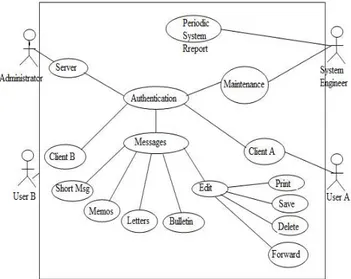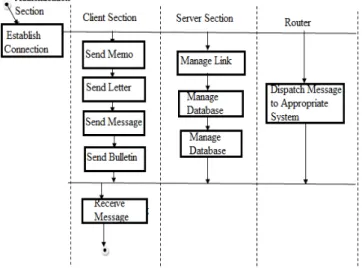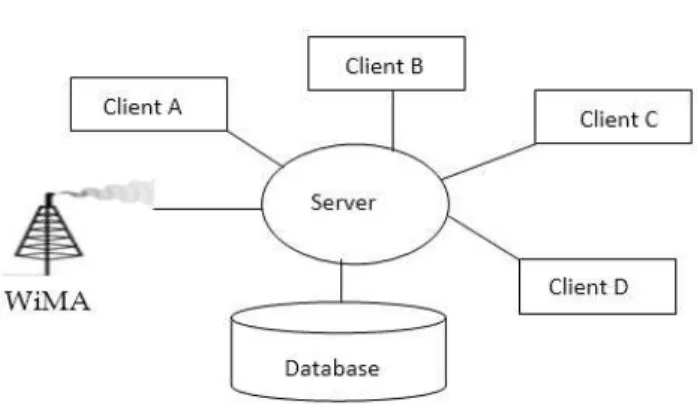A Model of Local Area Network Based Application
for Inter-office Communication
George Elechi Christopher, Israel Etuand Kufre Esenowo Jack
Abstract–In most organizations, information circulation within offices poses a problem because clerical officers and office messengers usually dispatch letters and memos from one office to another manually. Sequel to this circulation procedure, implementation of decisions is always difficult and slow. On one hand, clerical officers sometimes divulge confidential information during the process of receiving and sending of mails and other documents. On the other hand, money is wasted on the purchase of paper for printing. However, it is cheerful to learn that technology has made it possible for staff, structures and infrastructures to control and share organization resources; hardware; software and knowledge by means of modern electronic communication. One cannot deny the fact that the flow of information is very imperative in every organization as it determines the effectiveness of decision-making and implementation. This feat can be achieved using Object-Oriented System Analysis and Design Methodology (OSADM). This is structurally analyzed with Use Case Diagram (UCD), Class Diagram, Sequence Diagram, State Transition Diagram, and Activity Diagram. Moreover, the system is coded with Java 1.6 version, in a client-server network running on star topology in LAN environment. This is the concept of this paper. The system is designed to work in two parts – the control part that is installed on the server; and the messenger part that is installed in the clients. This research work integrates the utility and organization resources into a shared center for all users to have access to; and for free communication during office hours.
Index Terms–LAN; Client; Server; Java; Clerical officer.
I. INTRODUCTION
Every functioning system must comprise active subsystems; and for the main system to comprehend its objectives, the communication trends of the subsystem must be certainly effective. Mbam (2009) stated that networks enable clients to share resources (printer, software, scanner, camera, files or documents, mails or messages etc.).
Manuscript received August 13, 2016.
The paper title is A Model of Local Area Network Based Application for Inter-office Communication.
G. E. Christopher is with the Department of Computer Science, Akanu Ibiam Federal Polytechnic Unwana Afikpo, Ebonyi State, Nigeria (+2348062326461; georgeelechi@yahoo.com).
I. Etu is with the Department of Electrical/Electronic Engineering, Akanu Ibiam Federal Polytechnic, Unwana Afikpo, Ebonyi State, Nigeria (+2347061190525; iaetu@akanuibiampoly.edu.ng).
K. E. Jack is with the Department of Electrical/Electronic Engineering, Akanu Ibiam Federal Polytechnic, Unwana Afikpo, Ebonyi State, Nigeria (+2348034149749; kejack@akanuibiampoly.edu.ng).
A communication application can be designed to work on Local Area Network, for an organization to enable users share information concerning the organization. With this software, efficient sharing of company resources and smooth coordination of office information are ensured. With this, all memos and short messages can be sent between the network users even with the absence of internet facilities and telephone line. This is to allow the staff to have free communication with each other in a more friendly and efficient way using LAN-networked environment.
A. Aim
This research is aimed at developing messenger software, and ensuring that the systems are linked for effective communication.
B. Objectives
The objectives of this work include:
i. To design messenger software to be installed in an organization LAN for the purpose of information circulation.
ii. To build a model to ensure the security of messages transmitted on the system.
iii. To develop a model of a system that would keep track of information flow within the organization.
iv. To incorporate a model for an electronic bulletin board for the organization.
II. RESEARCH MATERIALS AND METHOD
A. Materials
The materials used in this work include Printer, JDK 1.6, XAMPP, Inno Setup Compiler, Active LAN, Clients and Server
B. Method
There are many existing methodologies for system analysis and design. However, the chosen methodology for this work is object-oriented system analysis and design methodology as well as unified processes of prototyping model with JDK 1.6 version of java.
III. PROPOSED SYSTEM MODEL
A model can also be said to be a simplified version of the real system. It is useful to think of a model as capturing aspects important for some applications while omitting (or abstracting) the rest. The considered model for the proposed system is Unified Model Language (UML). It can be used to correct nine different types of diagrams to capture five different views of a system. UML diagrams provide different perspectives of a software system to be developed and facilitate a comprehensive understanding of the system. Once a system has been modeled from all the required perspectives, the constructed models can be modified to get the actual implementation of the system. The UML diagrams capture the following views (models) of a system:
i. Users’ view
ii. Structural view iii. Behavioral view iv. Implementation view
v. Environmental view
Rajib (2010) stated that the program’s control flow structure indicates the sequence in which the program’s instructions are executed. Many programmers found it increasingly difficult not only to write correct programs, but also to comprehend and manage codes written by others. To braze up with this problem, experienced programmers advised others to pay attention to the design of a program’s control flow structure. A program having a good control flow structure would be easier to develop and understand. The main reason behind this situation is that normally one understands a program by mentally tracing its execution sequence to understand how the output is produced from the input values. The software was analyzed with CASE diagram.
Figure 1. The CASE Model for LAN Messenger
IV. CLASS DIAGRAM
The class diagram presents the static structure of a system. It shows how a system is structured rather than how it behaves. The static structure of a system comprises a number of class diagrams and their dependencies. The main constituents of a class diagram are classes and their relationships: generalization, aggregation, association, and
various kinds of dependencies. The description structures of this system can be extended with the below class diagram.
Figure 2. Illustration of the relationship classes diagram
V. SYSTEM PROCESSES
The system process is a well-arranged procedure of actions to accomplish a working system. A process is a series of actions directed towards a specific aim, or series of natural occurrence that produce change or development (Encarta, 2009). However, we analyze the system using a process flow diagram/sequence diagram as shown in figure 3 below.
This is a diagram that shows the processes that will be carried out in the system.
This above flow describes the process that takes places to accomplish the work of this research. The process follows from authentication users into the network, and then establishes links to nodes, after which messages can be sent from node to node (or nodes). The receiver then reads, saves, prints and replies messages. The above processes are synchronized for the success of the output, from the sender to the receiver and lastly to the respondents.
The detail of the process flow will be analyzed in details to show every process involved in the chain, from adding new user into the system, the necessary functions, termination and what happens to error messages.
VI. STATE TRANSITION DIAGRAM A state chart diagram is usually used to model how the state of an object changes in its life time. It is good in describing how the behavior of an object changes across several use case executions. State transition diagrams are based on the Finite State Machine (FSM) formalism. The object undergoes state changes when specific events occur. A state chart is a pyramidal model of a system which brings up the idea of a combined state (also referred to as nested state). Actions go with transitions and are seen, as processes that take place quickly without interruption. Activities have to do with states and can take longer; it can also be interrupted by an event. So, the state transition diagram of this research analysis is shown in figure 4 below
Figure 4: The state transition diagram
VII. ACTIVITY DIAGRAM
This activity diagram focuses on representing various activities or chunks of processing and their sequence of activation. An activity is a state with an in-house movement and one or more outgoing transitions which automatically follows the termination of the in-house movement. Activity diagrams are similar to the procedural flow charts. The main difference is that activity diagrams support the description of parallel activities and synchronization aspect involved in
different activities. Activity diagrams are also useful to understand difficult processing activities involving the roles played by many components. Besides helping the developer to understand the complex processing activities; it was also used to develop interaction diagrams that help to allocate activities (duties) to classes. This is shown in figure 5 below.
Figure 5. The activity diagram of the system
Table 1. The input designed table
VIII. DATABASE ARCHITECTURAL DESIGN
Figure 6: The database architecture
IX. THE HARDWARE ARCHITECTURE DESIGN
The diagram in figure 7 shows the connection of various sections which involves in the system.
The below diagram illustrated the arrangement of nodes on organization LAN. This shows exactly the nodes and its arrangement in every section in figure 6 above.
Figure 7: The network topological design
X. PSEUDO CODE OF THE PROGRAM
a. START CLIENT PROGRAM b. LOGIN
c. CHECK AUTHENTICITY d. IF OK
e. CONNECT LINKS f. LOAD MENU g. ITEM 1. SMS h. ITEM 2. MEMO i. ITEM 3. LETTER j. ITEM 4. BULLETIN k. SELECT ITEM 1 l. TYPE SMS m. SEND SMS n. RECEIVE SMS o. READ SMS p. DELETE SMS q. PRINT SMS
r. SELECT ITEM 2
s. REUSE LINE NO. 12 TO 16 t. SELECT ITEM 3
u. REUSE LINE NO. 18 v. SELECT ITEM 4 w. SEND MESSAGE x. READ MESSAGE y. PRINT MESSAGE
z. CLOSE CLIENT PROGRAM aa. START SERVER PROGRAM bb. ADMINISTRATOR LOGIN cc. USE PORT NUMBER
dd. USE CLIENT REGISTRATION IN DATA BASE
ee. SEND IP ADDRESS ff. CONNECT LINKS gg. MONITOR LINKS hh. SHARE RESOURCES ii. RESTRICT RESOURCES jj. END PROGRAM
kk. STOP
XI. SYSTEM IMPLEMENTATION
This system was implemented on Windows operating system with network facilities. The network topology could be any type, but there must be full interconnections between systems. These systems must have functioning working Ethernet card, and Transmission Control Protocol/Internet Protocol (TCP/IP) must be installed and well configured on all the systems of the network.
Two programs were designed for this system – one for the server and the other for the clients. The software meant for clients are installed on the clients while that of the server are installed on the server. The server would be able to see the client through the port address and assigned IP address to the client to enable it register and assume duty as a member of its node.
XII. EXPECTED AND ACTUAL RESULT
However, the system was designed and tested on dual core and Pentium system in a fully functioning LAN environment.
XIII. DISCUSSION OF RESULTS
This system was installed in a campus LAN with a cable network, and it worked efficiently except, of course, on some systems with bad LAN cable. However, the transmission was a bit slow, despite that the LAN speed was 86kbs. For the server to manage the database, there was the need to ensure that every transmission passes through network server instead of moving straight to the receiver system. This was what slowed down the information transmission speed. Nevertheless, the main objectives of the system were achieved.
XIV. CONCLUSION
The system was analyzed in a LAN environment, and the connection was properly systemized in a linked chain. Both the client application and server application were carefully installed and linked through the IP addresses, though the program recognized clients through the port numbers, for sending and receiving of signals from both ends to various units.
XV. RECOMMENDATION
The recommendation is for any researcher that is interested in this work to study further on how to integrate multimedia into this communication system. Also, he should work towards increasing the speed and extend this program to work on Wide Area Network (WAN).
REFERENCES
[1] I. A. Ajah and K. O. Igboji, Internet Fundamentals and File Management, Willyrose & Appleseed Coy, Abakaliki Nigeria, 2011.
[2] A. M. Youssef, Data Communication and Computer Networks, Concordia University, Montreal, 2012.
[3] R. Beaker, Reading in Groupware and Computer Supported Cooperative Work, Sam Meter, C. A, 1993.
[4] J. Cohen, Statistical Power Analysis for the Behavioral Science, Lawrence Erlbaum, HillDale, NJ. United State, 1988.
[5] M. Deepti and M. Alok, Effective Communication, Collaboration, andCoordination in eXtreme Programming: Human-Centric Perspective in a Small Organization, Department of Computer Engineering, Atilim University, Ankara, Turkey, 2012.
[6] M. F. Ditte and J. Rasmussen, What a Waste: How Your Computer Causes Health Problem in Ghana, 2011.
[7] W. N. Ekemezie and N. J. Ngene, Computer and Information Technology, Sam press Ltd Enugu, Nigeria, 2004.
[8] M. Ellis, Computer and Information Processing, Irwin inc, USA. Encarta, Microsoft Encarta Dictionary, Microsoft Inc. USA, 1991.
[9] S. E. Hutchinson and S. C. Sawyer, Using Information Technology, 3rd Edition, Irwin, McGraw-Hill Boston, USA, 2000.
[10] W. Mardav, Computer Networks are Essential for Day-to-day Communication, University of Tennessee, 2006. [11] B. C. E. Mbam, Internet Made Easy, Academic Treasure
International, Abakaliki, Nigeria, 2009.
[12] T. J. Mowbray and R. Zahavi, The Essential CORBA: Systems Integration using Distributed Objects (pp. I-XVI). New York: Wiley, 1995.
[13] O. O. Okechukwu, Introduction to System Analysis and Design, Madonna University Press Ltd, Uwani Enugu, Nigeria, 2009.
[14] R. Orfali, D. Harkey and J. Edwards, Essential Client/Server Survival Guide, John Wiley & Sons, United Kingdom, 1994. [15] A. Palo, A New Traffic Control Algorithm for Packet
Switching Networks, Lixia Zhang XEROX Palo Alto Research Center, Coyote Hill Road, Canada, 2003. [16] M. Pidd, Computer Simulation in Management Science,
John Wilet & Sons. Chichester England, 1998.
[17] M. Rajib, Fundamentals of Software Engineering, PHI Learning private Limited, New Delhi, India, 2010.
[18] S. Robinson, Successful Simulation: A Practical Approach to Simulation Projects, McGraw-Hills Maiden, England, 1994. [19] M. Stephen, CCNA Self-Study: Introduction to Cisco
Networking Technologies, Cisco Press CA, USA, 2008. [20] B. K. William, The Essential Client/Server Survival Guide,
John Willey and Sons Inc. Chichester, England, 1999. [21] C. Wiley, Periodicals InterScience, Inc. Published online,
(www.interscience.wiley.com). DOI: 10.1002/hfm.20164, 2009.


